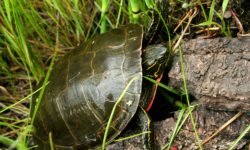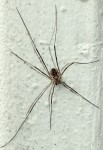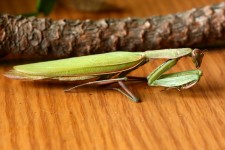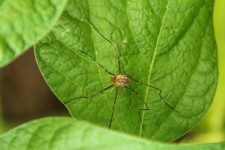A flash of blue darted across the ground in front of me as I entered Grandma’s barn—a blue-tailed skink! Luckily, the skink paused long enough for me to take a picture with my phone before it darted under a tarp.

Blue-tailed skink (Plestiodon skiltonianus), more commonly called western skink, are elusive lizards that prefer to hide in their burrows, in crevices, under rocks or leaf debris while not foraging. I felt extremely lucky to see one last summer.
Western skink can be identified by the tan, cream and brown stripes that run their entire length (up to eight inches). Unlike other lizards found in Idaho, western skink have a smooth, shiny body. Their tail is extremely long—up to two times their body length.
Not many things found in nature are blue, so I knew once I saw the blue tail it was a western skink. Only juveniles exhibit the bright blue tail. As the skink reaches adulthood the tail color fades to a light blue or gray.
One might think a bright blue tail would hone predators right in to the western skink and it does in a good way. If a predator, such as a raptor, does spy the skink, it will most likely grab the bright blue tail. To survive, the skink will detach its tail! The tail wiggles vigorously when detached for several minutes to distract the predator from the skink escaping. The tail will grow back slowly but often darker, bigger, oddly shaped and rarely blue.
Another unique trait of western skinks compared to all other native reptiles in the Pacific Northwest is that females display parental care of the eggs. In June or July the female digs in loose, moist soil under a rock to make a nest chamber and lays two to six white eggs. She warms the eggs when necessary by basking in the sun and then returning to the nest. The females stays and guards the eggs and hatchlings until they are old enough to leave the burrow in late summer.
Both males and females stay relatively close to their burrows. They live in areas with abundant plant cover, sunny openings for basking, and abundant rocks, stumps and logs for foraging and hiding. Western skinks prefer to live near water or moist areas and avoid heavy brush and dense forests. They prefer grassy areas, hillsides, talus slopes and rocky/brush areas found in ponderosa pine or interior Douglas fir ecosystems. Occasionally they live in cedar-hemlock or Engelmann spruce-subalpine fir ecosystems.
No matter where western skink live, they need abundant arthropods (insects, spiders) to forage upon. They mainly eat crickets, beetles, moths, grasshoppers, flies, spiders and earthworms. To catch their prey they use quick movements, speed and striking in a snake-like fashion.
However, western skinks don’t venture far from shelter so they can quickly wiggle under a nearby rock or log if threatened by a predator. Luckily for the western skink I saw out in the open, I wasn’t a predator and it escaped to safety with its tail.





Lovely script you exhibit.
I was sitting on my front porch in joying my morning coffee when I looked down and saw this amazing little guy! Thing is I’m in Ohio and wonder if this is a rarity? My flower beds are loaded with grasses and rocks and lots of ground cover , so I’m thinking perfect for them, so I’m just wondering if there’s 1 could there possibly be more?